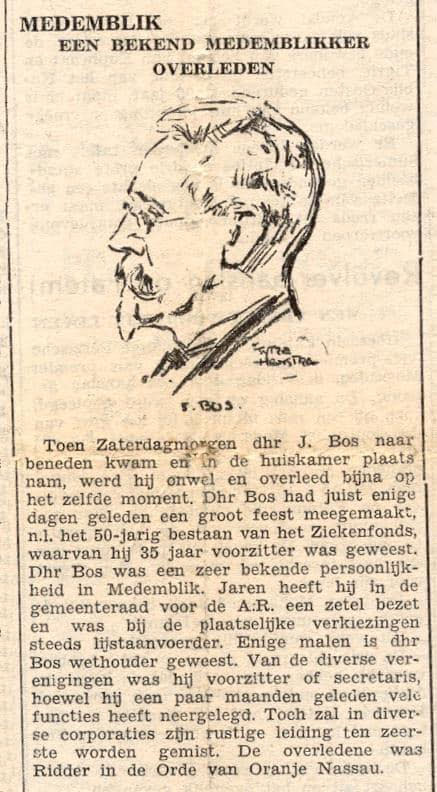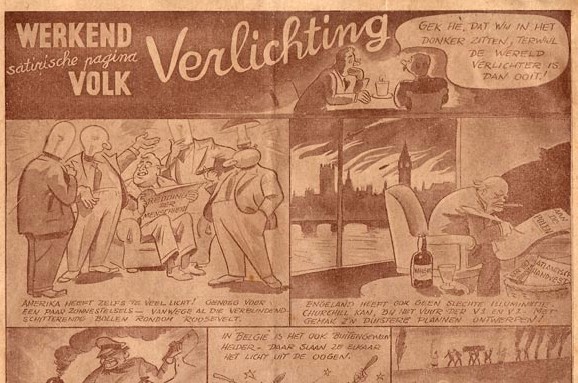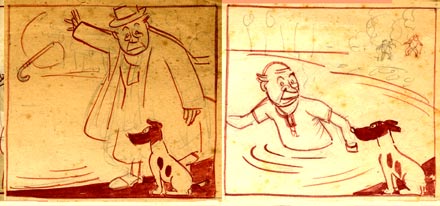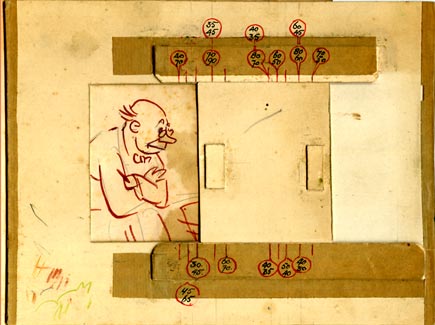Sports commentary in De Telegraaf, 28 January 1936.
Sytze Henstra was a Dutch illustrator, cartoonist and painter, mostly known for his sports cartoons for newspaper De Telegraaf from the 1930s to the 1960s. He also illustrated for local West-Frisian newspapers, and made a satirical cartoon feature for the national-socialist newspaper Werkend Volk during World War II.
Early life and work
Sijtze Dirk Henstra, generally referred to as Sytze Henstra, was born in 1894 in the Frisian city of Sneek. The Henstra family moved to the province North Holland around 1900, where they settled in Enkhuizen in the West Frisia region. The local newspaper Enkhuizer Courant proudly reported on 2 July 1912 that Henstra had passed his entrance exam for the National Normal School for Art Teachers ("Rijksnormaalschool voor Tekenonderwijzers") in Amsterdam. He attended the school until 1913, and had painter Carl Fahringer as one of his teachers. He later returned to Enkhuizen, where he settled in a job as a drawing teacher.
Henstra's 1932 illustration of (former) Medemblik councilman Jan Bos (1871-1952) was reused in Bos' obituary in February 1952 (Bos was, by the way, the great-grandfather of Comiclopedia editor Bas Schuddeboom).
Early illustration career
Henstra was additionally active as an illustrator/caricaturist for local newspapers. Around 1932, he made pen drawings of the chairman of the West Frisian Society, doctor G.C. van Balen Blanken, as well as the city council of the neighboring town Medemblik. He also made drawings for De Autobus, the official magazine of the Dutch Society of Bus Service Enterpreneurs ("Nederlandse Bond van Autobusdienst-ondernemers"). In his spare time, he made paintings, including townscapes of Enkhuizen. He later lived in Zwolle for a while, where he served as caricaturist for the Provinciale Overijsselsche en Zwolsche Courant.
From: De Courant/Het Nieuws van den Dag, 8 May 1941.
Sports cartoonist for De Telegraaf
By the mid-1930s, Henstra was living in Amsterdam, where he found employment with national newspaper De Telegraaf. He became the paper's regular sports cartoonist, often commenting on the news of the day in sequential narratives. Henstra contributed to the paper and its companion paper De Courant/Het Nieuws van den Dag on a regular basis until at least the 1960s. By the 1950s, he was one of the best known sports cartoonists in the Netherlands, along with Bob Uschi and Dik Bruynesteyn.
"Werkend Volk'.
World War II propaganda
During World War II, Sytze Henstra remained associated with De Telegraaf, a paper placed under Nazi supervision. He also contributed to other publications with national-socialist sympathies. Using pen names like Redbad and Hensy, Henstra, for instance, drew a satirical comic page for Werkend Volk, the propaganda magazine for Amsterdam's national-socialists. Henstra's comics were not per se antisemitic, but spoofed the Dutch people and the liberators. Around the same period, as Hensy, he made a comic strip called 'Meneer Papmeijer'.
Panels of 'Mijnheer Papmeijer', and the template Henstra used for drawing his frames (with slider).
Henstra provided cover illustrations for Dutch translations of German propaganda books like 'Mutter erzähl mir etwas von Adolf Hitler' ('Moeder, Vertel Eens Wat Van Adolf Hitler', 1942) by Johanna Haarer and 'Das Reich des Führers' ('Het Rijk van den Führer', 1943) by Johannes Ohquist for publisher Westland. Henstra also made the interior illustrations for the book 'Het Wonder der Erfelijkheid' (1943), in which veterinarian G.A.M. de Monyé defended the importance of racial purity with examples from the animal world. The cover illustration was designed by Pieter Kuhn. Henstra is additionally believed to be the illustrator of 'Het Lied van Levie' (De Misthoorn, 1941), a reworking of a late 19th-century German story, in which the Jewish people are brutally mocked and portrayed as disruptors of society. The booklet is signed with Brinio, and the writer is supposedly Arie van der Oord.
Post-war life
After World War II, Henstra resumed his work as sports caricaturist for De Telegraaf. It is unknown whether he was ever convicted for his wartime activities. He passed away in Amsterdam in 1991 at the age of 96. His son Friso Henstra (1928-2013) was also a Dutch illustrator and comic artist.
Illustration for a contest regarding the sports news of 1965, published in De Telegraaf on 24 December 1965.









